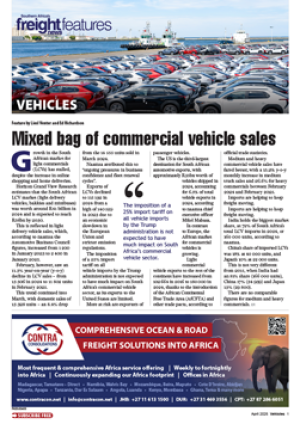South African ports
should be opened to
private operators and
focus on up-skilling to
curb spiralling tariffs that are
driving traffic to competitor
ports developing on the
continent.
This is the view of analysts
who told FTW that although
still among preferred
destinations for global trade
with the continent, the
country’s ports were probably
among the least competitive in
the world and fast losing the
edge against other regional
ports.
Christie Viljoen, senior
economist at NKC Independent
Economists, said the global
trend to privatise public sector
services would have cost and
efficiency benefits for port
operations.
“Our ports have
seen a steady decline in
competitiveness over the past
decade as the government
has made significant upward
adjustments to administered
prices,” he said.
Viljoen said price hikes had
outpaced much lower increases
in port costs associated with
developed economies, where
cost inflation had been
“relatively benign” in recent
years. He added that more
expensive electricity was partly
to blame for rising costs.
Viljoen said the gap
between the competitiveness
of local ports and ports on the
continent was “fast closing” and
in some cases had closed.
“Ports in Mozambique and
Namibia are attracting cargo,
both imports and exports,
from across SADC countries.
Previously, South African
ports were seen as a default to
shipping these goods to Asia
and Europe. Not any more,”
he said.
Local ports are no longer
mainstay ports for landlocked
countries like Zambia,
Botswana and Malawi, he
added.
“Malawi, for example,
favours Mozambican ports,
while Botswana is increasingly
looking to Namibia for trade
facilitation.”
Hannah Edinger, Frontier
Advisory director, said much
SADC cargo was still routed
through local ports such as
Durban but cargo owners and
shipping lines were looking for
alternatives due to congestion
and delays.
“South Africa’s ports and
network infrastructure have
been key to the country’s
gateway status for trade into
southern Africa. However,
increasing competition is
arising as regional neighbours
invest in their port and other
infrastructure capacity and
capabilities, potentially
diverting freight from South
Africa,” Edinger said.
East-West infrastructure
corridors, including Maputo-
Walvis Bay; Lobito-Nacala
and the Mwambani-
Banana corridor – still in
conceptualisation phase – could
also facilitate trade into the
interior, bypassing South
Africa, she said.
She added that Transnet’s
R300 bn Market Demand
Strategy (MDS), including port
and terminal developments,
planned for the next
decade would improve
competitiveness.
“A critical input though
for implementing the port
development plans and to up
the level of port operations
to international standards is
the need to build a solid skills
base,” she said.
Kira McDonald, an Analyst
at Frontier Advisory, said
when shipping lines and
agents analysed ports for
competitiveness they focused
on the number of vessels
calling per week; ocean
freight rates; transit times and
trucking charges.
MacDonald said the
expanding Dar es Salaam Port
for example was attractive to
shipping lines as it was closer
to end user markets in the
Middle East, China and
India. Other major port
infrastructure projects offering
competition to SA included
the Mombasa port expansion,
Lekki Port in Nigeria and
Nacala in Mozambique.
CAPTION
The Port of Mombasa... expansion under way.

